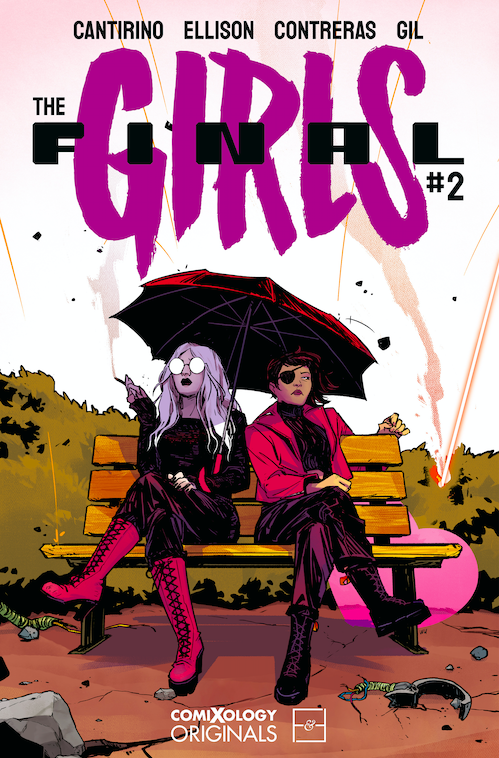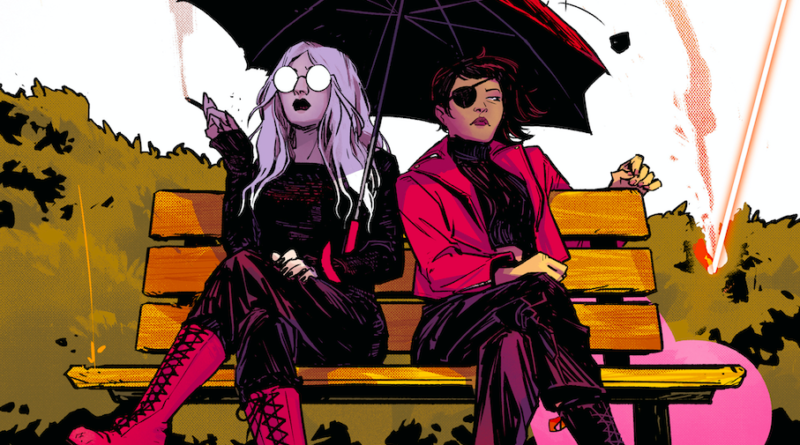INTERVIEW: Cara Ellison on her new comic ‘The Final Girls’
Image courtesy of comiXology / Art by Annie Wu / Provided with permission.
Imagine a not-too-distant future with almost no superheroes left in the public spotlight, with some deciding to retire and go underground, yet the world is still in crisis mode and in need of some assistance. Cara Ellison’s new five-issue comic, called The Final Girls, is out now from comiXology, a leading publisher of digital comics. In addition to Ellison’s story, fans can check out art by Sally Cantirino, colors by Gab Contreras and lettering by Joamette Gil. Guest covers are provided by Annie Wu, Audrey Mok, Tula Lotay and Olivia Stephens.
Here’s how comiXology describes the narrative: The Final Girls is part dark comedic superhero drama and part dystopian political thriller. The story is set in 2030, six years after the disbanding and disappearance of the so-called “Final Girls,” consisting of Kogarashi, Bavanshee, Selkie and Ash, but they are unable to stay retired for too long. Scathach, a powerful hero who still fights for justice, needs some help, and she asks the Final Girls to come back into the spotlight.
Recently Hollywood Soapbox exchanged emails with Ellison about the new series. She currently serves as senior narrative designer for AGDA Studio of the Year League of Geeks. She has worked in journalism, books, comics and radio. Questions and answers have been slightly edited for style.
Do you think this five-issue comic is a commentary on superheroes and how they have been written in the past?
This comic is definitely in conversation with how superheroes have been written or talked about, particularly where female pain is a kind of emotional trampoline for male-driven plots. The apocryphal sexual assault of Wonder Woman, as well as some of the ways that big superhero comics tend to airdrop in dead girlfriends, assault, revenge porn or sexual humiliation of women characters — these usually act as an easy semaphore flag that reads ‘look, these men are bad’ rather than taking time to make the women have depth or even be ‘bad’ too. They get maybe a page or less to tell you about their lives before having to give over to the men again.
Refusing to let the women have agency in a gritty world, sexualizing their suffering or having them be passive receivers of whatever the male characters charitably give them is something that happens a lot in a number of big superhero comics and in recent screen incarnations of comic book characters. I think it’s BS that women would stay victims in a Bad Gritty World. Women already live in a bad gritty world, and we survive it. Generally speaking, I love gritty comics, and I don’t think these tougher themes are off-limits. But I wanted to write about women handling the f***ups and gritty world for once, and let them have the emotions about it instead of about Men Knowing Best or Bad Men Putting Things Right.
However, most good metastories depend on the hard work of a lot of creators that have gone before them, so I do have to thank a great deal of creative teams that have worked on books like The Boys and Watchmen, and TV shows like Jessica Jones, the latter of which I think successfully revealed how psychological horror is an aspect of being a woman even when you are superhumanly strong. If you liked season one of Jessica Jones, this is the comic for you.
Is highlighting abuse of power an important theme you wanted to come across?
It’s about how the hell you handle it when it happens. No one knows how to do it unless it’s just sending people to jail or (specifically in hero comics) beating the crap out of them. Does that stop it happening? Stats say no. Abuses of power happen all the time in reality, quite serious ones, and even when you have seen them happen countless times before, it’s always difficult to know how to handle it.
Abuse of power is really only allowed to continue because it happens within tight-knit social and economic fabrics that benefit from cohesiveness. If your community relies on a particular set of people or a person continuing to be successful for you to survive, then when that person steps over a line it is very likely people will be afraid to do anything about it for fear that they’ll be ostracized. And they very often are ostracized for doing the ‘right thing,’ which is reporting it to an authority (who won’t do much about it) or publicizing it (which often doesn’t constrain the worst offenders and usually comes back on the reporter instead).
A good example of this dynamic is in Watchmen. What does Hooded Justice do when he sees The Comedian cross the line in Watchmen? He beats the crap out of him. But his lawyer tells him not to do anything further because then The Minutemen’s means of survival is done. So he is allowed to stick around, even though Silk Spectre has to continue to work with him.
The Final Girls is about women who try another way.
How would you describe each of the ‘final girls’?
The Final Girls are a loose group of superheroes that have retired to Scotland to have a quieter life. They began their herodom working mostly in the U.S. where the big money was, but superheroes got increasingly politicized and bashed in the press there. So when they moved back to Scotland, the press dubbed them ‘The Final Girls’ after the trope of the escapee in a horror movie.
Selkie is a changeling, just like the Scottish mythical creature; Bavanshee is a vampire from the Highlands (also from Scottish mythology); Osua is a Scots-Ghanaian hero who can move and control water; and Ko has the worst power of the lot, the power to absorb all emotion from someone with just a touch. Then she gets to feel those emotions herself, which is a treat when you’re around a lot of people in various states of anger and distress.
Why set the story in Scotland? What do you like about this country as a backdrop?
The simple answer is that I’m from here. I know it well. It’s very pretty. It can be bleak, but it has a kind of static, entrenched feeling where the U.S. is very changeable, infrastructure is often a little less robust, and the feeling can be one of time, interests, attentions passing desperately fast. It can be tiring to get caught up in the speed of the U.S. way of life. So Scotland’s the ideal retirement for a superhero who wants to just walk into the wilderness and never be found again.
Do you feel that there are more stories to be told beyond five issues?
The Final Girls are quite mercenary, so the next One Last Job would have to be extremely lucrative.
What was it like to work with artist Sally Cantirino?
Sally is really good at grasping exactly what the vision is and produces excellent punk-rock/horror vibes that I think make the darker themes really pop. She was a pleasure to work with. She brought out the character expressions really well, too.
There is some tremendous work coming from female writers and female artists, but more work needs to be done to get more voices out there. Have you seen changes in the comic industry? Positive? Negative?
Though I’ve been a working writer for about eight years, this is my first creator-owned piece of work in comics. I did two previous short comics and the comic-book styled game Void Bastards, so I don’t think I’m particularly qualified to speak on this question. It’s really a question of whether women and other underrepresented people are supported to stay here.
Kelly Sue Deconnick’s work was a huge influence on me, and Irene Koh’s work has also been a massive influence on my seeing what comics can do from the start. I hope that they get to maintain their influence. Our Final Girls team, comprised of women and non-binary creators, was a dream to work with. I would like to see the industry continue to sustain and support creators like our team, and lift them up.
But we will lose a lot of talented women, BIPOC and non-binary creators from comics if we don’t make it economically viable and safe to continue to work here — we need people to continue not just buying our work, but talking about it, making it safe for us, and we need publishers to commission and pay for our work up front. We were lucky that comiXology was looking for our kind of work — now we just have to get people to read it. So definitely do that! Go do it!
By John Soltes / Publisher / John@HollywoodSoapbox.com
The Final Girls, by Cara Ellison and featuring art by Sally Cantirino, is now available from comiXology. Click here for more information.


